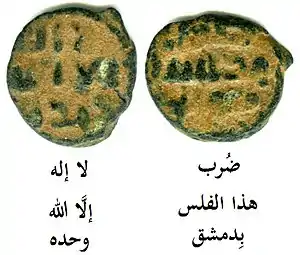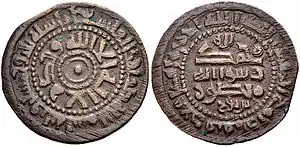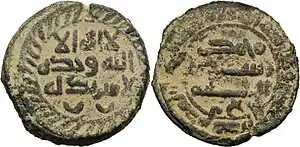Fals
The fals (Arabic: فلس, romanized: fals, plural fulus) was a medieval copper coin first produced by the Umayyad caliphate (661–750) beginning in the late 7th century. The name of the coin is derived from the follis, a Roman and later Byzantine copper coin.[1] The fals usually featured ornate Arabic script on both sides. Various copper fals were produced until the 19th century. Their weight varied, from one gram to ten grams or more.

A fals minted in Damascus between 696 and 750

Fals of Mansur ibn Nuh, minted in Bukhara, AH 353 (964 CE), commemorating the Abbasid caliph al-Muti
The term is still used in modern spoken Arabic for money, but pronounced 'fils'.[2] It is also absorbed into Malay language through the word fulus فولوس.[3]
In popular culture
- The Malay derivant fulus was used as basis for naming the fictional setting of Metrofulus in the 2006 Malaysian superhero film Cicakman.
See also
Daughter currencies:
References
- Urban network evolutions : towards a high-definition archaeology. Aarhus: Aarhus University Press. 31 December 2018. p. 118. ISBN 9788771846386.
- Stephen Album, Checklist of Islamic Coins, Santa Rosa, CA, 2011, third edition, p. 7
- "fulus". Kamus Dewan (4th ed.). Dewan Bahasa dan Pustaka Malaysia. Retrieved 6 September 2020 – via Pusat Rujukan Persuratan Melayu.
This article is issued from Wikipedia. The text is licensed under Creative Commons - Attribution - Sharealike. Additional terms may apply for the media files.
